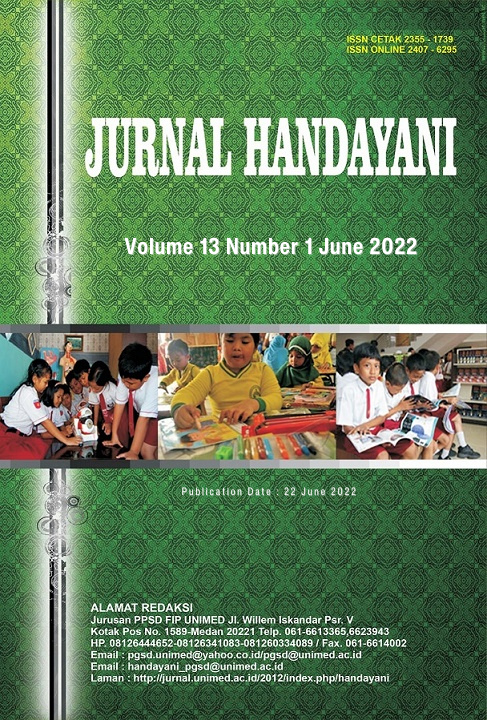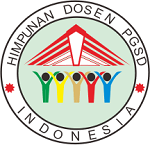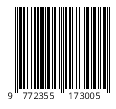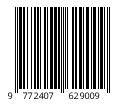PENGEMBANGAN MODUL MEMBACA PERMULAAN BERBASIS STRUKTURAL ANALITIK SINTETIK (SAS) UNTUK KELAS 1 SEKOLAH DASAR
DOI:
https://doi.org/10.24114/jh.v13i1.36011Abstract
AbstrakHasil observasi dan wawancara awal yang telah dilakukan terhadap guru kelas 1 di SD Negeri 38 Palembang, terdapat beberapa siswa yang mengalami kesulitan membaca, masih ada siswa yang belum bisa membedakan huruf, dan belum hafal huruf abjad. Salah satu metode yang dapat memotivasi peserta didik dalam belajar dan menumbuhkan minat siswa dalam belajar adalah dengan menggunakan pengembangan modul membaca permulaan berbasis SAS (Struktural Analitik Sintetik). Metode penelitian ini menggunakan metode research and development dengan batas penelitian penilaian ahli dan praktikalitas. Penilaian ahli dilakukan pada ahli media, bahasa, dan materi, sedangkan praktikalitas dengan guru dan siswa. Teknik pengumpulan data menggunakan dokumentasi dan angket, sedangkan teknik analisis data menggunakan persentase. Hasil dari dari tahapan pengembangan adalah menghasilkan produk modul membaca permulaan berbasis Struktural Analitik Sintetik (SAS) pada materi membaca permulaan kelas I SD. Hasil penilaian para ahli menunjukkan bahwa modul membaca permulaan berbasis Struktural Analitik Sintetik (SAS) dengan persentase sebesar 89,91%. Dengan demikian, dapat disimpulkan bahwa pengembangan modul membaca permulaan berbasis Struktural Analitik Sintetik (SAS) pada materi membaca permulaan kelas I SD termasuk dalam kategori sangat valid atau sangat layak. Dari hasil praktisi yaitu guru dan siswa diperoleh persentase sebesar 97,62%. Dengan demikian, dapat disimpulkan bahwa kelayakan modul membaca permulaan berbasis Struktural Analitik Sintetik (SAS) pada pembelajaran kelas I Sekolah Dasar termasuk dalam kategori sangat layak.Kata Kunci: modul, membaca permulaan, struktural analitik sintetik (SAS)AbstractThe results of preliminary observations and interviews that have been conducted on grade 1 teachers at SD Negeri 38 Palembang, there are some students who have difficulty reading, there are still students who cannot distinguish letters, and have not memorized the letters of the alphabet. One method that can motivate students in learning and foster student interest in learning is to use the development of a SAS (Structural Analytic Synthetic)-based beginning reading module. This research method uses research and development methods with the limits of expert judgment and practicality. Expert assessment is carried out on media, language, and material experts, while practicality is carried out with teachers and students. Data collection techniques use documentation and questionnaires, while data analysis techniques use percentages. The result of the development stage is to produce a product of Structural Analytical Synthetic (SAS)-based early reading modules for the first grade elementary reading materials. The results of the expert's assessment showed that the initial reading module was based on Structural Analytic Synthetic (SAS) with a percentage of 89.91%. Thus, it can be concluded that the development of the Structural Analytical Synthetic (SAS)-based early reading module for the first grade elementary reading material belongs to the very valid or very feasible category. From the results of practitioners, namely teachers and students, a percentage of 97.62% was obtained. Thus, it can be concluded that the feasibility of the Structural Analytic Synthetic (SAS) starting reading module in the first grade learning of Elementary School is in the very feasible category.Keywords: module, beginning reading, synthetic structural analytic (SAS)Downloads
Published
2022-06-22
How to Cite
Putry, S. W., Aryaningrum, K., & Fakhrudin, A. (2022). PENGEMBANGAN MODUL MEMBACA PERMULAAN BERBASIS STRUKTURAL ANALITIK SINTETIK (SAS) UNTUK KELAS 1 SEKOLAH DASAR. JURNAL HANDAYANI PGSD FIP UNIMED, 13(1), 122–129. https://doi.org/10.24114/jh.v13i1.36011
Issue
Section
Articles
License
Copyright (c) 2022 Silfhina Wijaya Putry, Kiki Aryaningrum, Ali Fakhrudin

This work is licensed under a Creative Commons Attribution-ShareAlike 4.0 International License.
Authors published with the Handayani PGSD FIP UNIMED Journal agree to the following terms:
- Authors retain copyright and grant the journal the right of first publication with the work simultaneously licensed under a Creative Commons Attribution License (CC BY-SA 4.0) that allows others to share the work with an acknowledgment of the work's authorship and initial publication in this journal.
- Authors are able to enter into separate, additional contractual arrangements for the non-exclusive distribution of the journal's published version of the work (e.g., post it to an institutional repository or publish it in a book), with an acknowledgment of its initial publication in this journal.
- Authors are permitted and encouraged to post their work online (e.g., in institutional repositories or on their website) prior to and during the submission process, as it can lead to productive exchanges, as well as earlier and greater citation of published work. (See The Effect of Open Access)
















